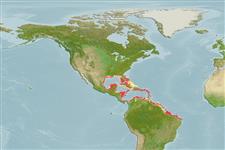Teleostei (teleosts) >
Mugiliformes (Mullets) >
Mugilidae (Mullets)
Etymology: Mugil: Latin, mugil, -ilis = grey mullet (Ref. 45335).
More on author: Poey.
Environment: milieu / climate zone / depth range / distribution range
Ecology
Marine; freshwater; brackish; pelagic-neritic; catadromous (Ref. 46888). Subtropical; 30°N - 6°S, 98°W - 34°W
Western Atlantic: Florida, USA to northeastern Brazil.
Length at first maturity / Size / Weight / Age
Maturity: Lm 16.0, range 14 - ? cm
Max length : 46.0 cm TL male/unsexed; (Ref. 7251); common length : 15.0 cm TL male/unsexed; (Ref. 5217); max. published weight: 190.00 g (Ref. 9626)
Occur in coastal water, brackish lagoons and lower reaches of rivers (sometimes in freshwater) (Ref. 3791). Feed on small algae and other organic matter (Ref. 3791). Oviparous, eggs are pelagic and non-adhesive (Ref. 205).
Life cycle and mating behavior
Maturities | Reproduction | Spawnings | Egg(s) | Fecundities | Larvae
Cervigón, F., 1993. Los peces marinos de Venezuela. Volume 2. Fundación Científica Los Roques, Caracas,Venezuela. 497 p. (Ref. 9626)
IUCN Red List Status (Ref. 130435)
Threat to humans
Harmless
Human uses
Tools
Special reports
Download XML
Internet sources
Estimates based on models
Preferred temperature (Ref.
123201): 24.4 - 28, mean 27 °C (based on 244 cells).
Phylogenetic diversity index (Ref.
82804): PD
50 = 0.5000 [Uniqueness, from 0.5 = low to 2.0 = high].
Bayesian length-weight: a=0.01514 (0.00934 - 0.02453), b=2.96 (2.82 - 3.10), in cm total length, based on LWR estimates for this species & Genus-body shape (Ref.
93245).
Trophic level (Ref.
69278): 2.0 ±0.00 se; based on food items.
Resilience (Ref.
120179): Medium, minimum population doubling time 1.4 - 4.4 years (tm=2).
Fishing Vulnerability (Ref.
59153): Moderate vulnerability (36 of 100).
Nutrients (Ref.
124155): Calcium = 205 [69, 608] mg/100g; Iron = 3.16 [0.59, 15.54] mg/100g; Protein = 20 [18, 21] %; Omega3 = 0.548 [0.242, 1.334] g/100g; Selenium = 42.5 [14.4, 140.4] μg/100g; VitaminA = 8.9 [2.4, 36.0] μg/100g; Zinc = 2.19 [1.03, 5.38] mg/100g (wet weight);
